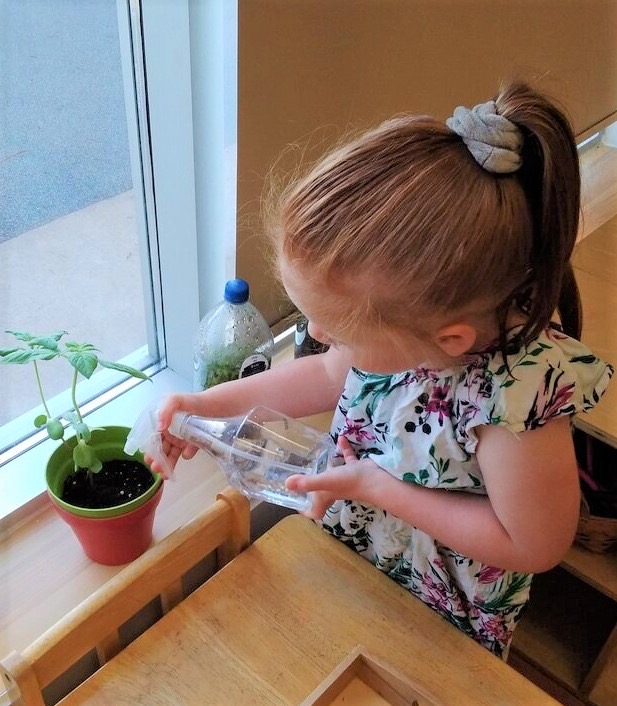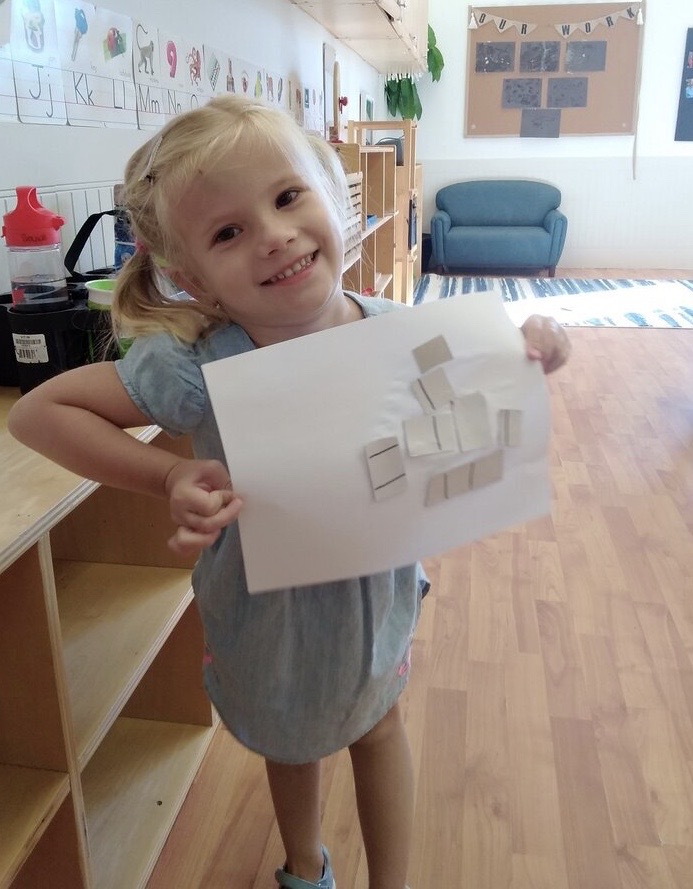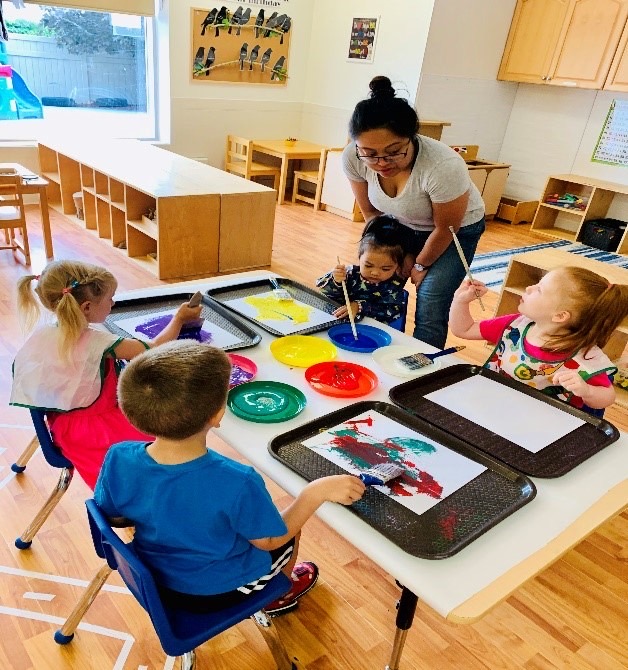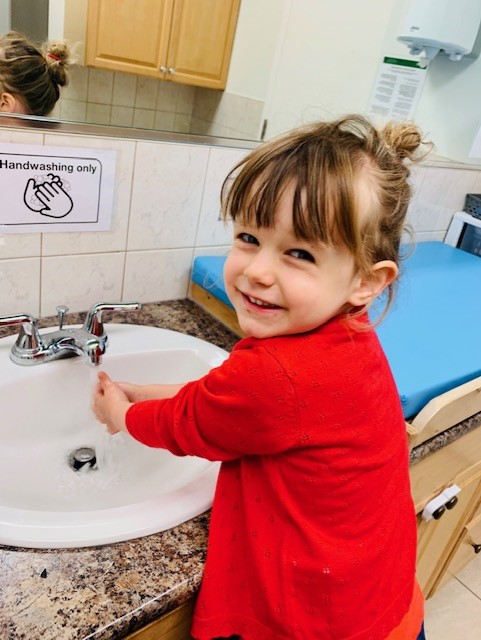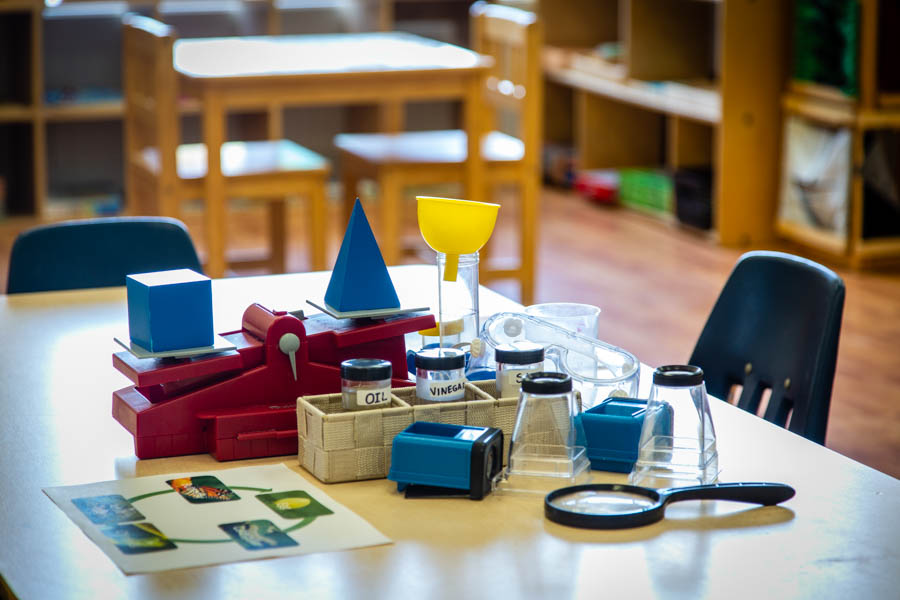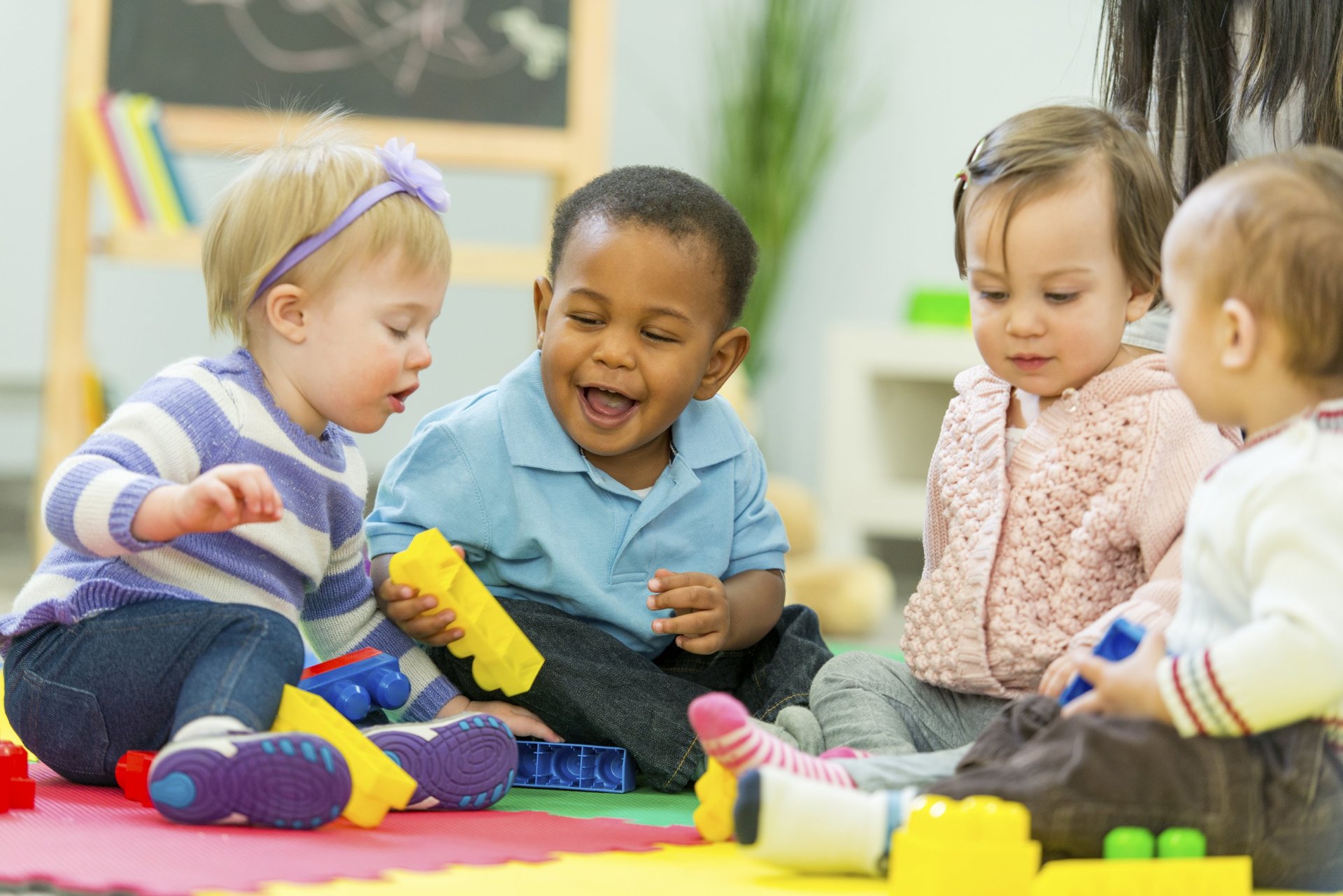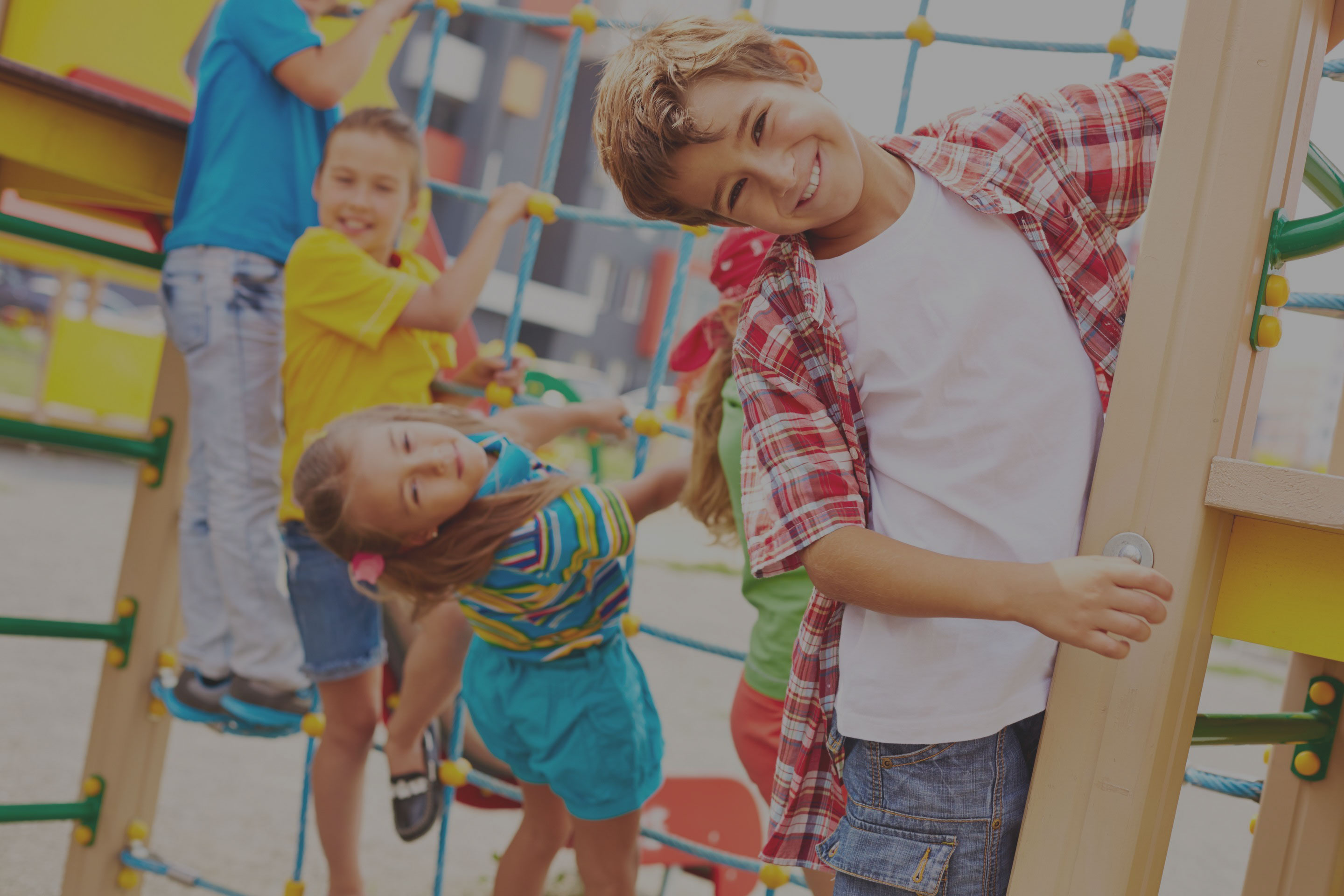Have you ever wondered why they call it Kindergarten?
Have you ever wondered why they call it Kindergarten?
As many parents get ready to send their little 4 -5 year olds to Kindergarten, you may be wondering why we call it Kindergarten. The word kindergarten comes from the German language. The term dates to the 1840’s and was created by Friedrich Froebel who started the first kindergarten, “Garden of Children “.
The word Kindergarten symbolized his vision for early childhood education: “Children are like tiny flowers; they are varied and need care, but each is beautiful alone and glorious when seen in the community of peers.” Before 1840, children under the age of 7 did not attend school yet. Froebel was an educator who believed in hands-on learning for children. He also had a love for nature, science, architecture, and mathematics. He felt children needed to be “nurtured and caringly tended to like plants in a garden.” Hence, he founded an early education program for young children, which he called kindergarten.
It was a place where children could develop and flourish freely through self- directed play under the guidance, not direction, of the teacher. His belief system was an inspiration to many educators and philosophers including Maria Montessori. It is easy to see his influence in her work. Maria Montessori was the first to introduce a child-sized environment. She wanted the children to feel that the classroom belonged to them rather than the teachers.
These ideas have had a huge impact on how preschool and kindergarten have developed over the years. As we approach back to school this year amongst uncertainty due to the global pandemic, we must remind ourselves of the initial motivation, “Children are like tiny flowers; they are varied and need care. “Like plants and flowers, children are fragile yet resilient. Parents and educators alike share the responsibility of keeping these precious little ones safe. We want to provide a place for them to grow and flourish while shielding them from the elements!
At Alpha’s Discovery Kids Preschool and Daycare, we are growing too. We have created a new Kindergarten program where children 3.5-5 years old can grow and flourish in a place that belongs to them. We have enhanced our Four Pillars of Learning curriculum for this age group to challenge them further. Our stimulating program allows children to grow along side their peers and gives parents the reassurance that their children are in a safe environment. We have large classrooms with less then full capacity ratios to create more space for physical distancing within the day. If you would like to find out more about our Kindergarten program, click here.
Wherever you may choose to grow your flower(s) let us not lose sight of the foundations, inspirations and intentions set into motion in 1840 with “Kindergarten”! We wish all our little flowers a prosperous year full of growth and new learning opportunities!
Sr. Preschool/Kindergarten Program – Ages 3.5-5 years
SENIOR PRESCHOOL/KINDERGARTEN PROGRAM – AGES 3.5-5 years
Alpha’s Discovery Kids Sr. Preschool/Kindergarten program offers advanced academic opportunities which promote learning readiness for primary school preparation. Our Kindergarten program is based on our unique curriculum called the Four Pillars of Learning, which incorporates a holistic approach to learning using the four pillars. As our students become more independent, we can devote more time to an increased level of academics. We approach this as an opportunity to build upon each child’s abilities and strengths to reach full potential in all areas. Our holistic approach is consistently based on providing a sense of belonging, engagement, security, and nurturing. We provide an environment that is stimulating, fosters curiosity and encourages inquiry-based learning. We provide child-led and teacher supported learning experiences to encourage the mental, physical and spiritual growth of our students. We strive to achieve the utmost quality of care while working along side families as a partnership. The relationship we strive to create allows us to fully to embrace, encourage and maximize learning and support well being in each individual child. This program is designed to build skills, confidence and empower the “Alpha” in each one of our students before moving into the primary grades.
Four pillars planning time –The children will come to the table to gather where they will have their printing cards ready for them. During this gathering time the educator will present any new options that are available in the room for the morning work period. The children will have an opportunity to choose which activities they would like to work on, or what materials they would like to explore. The educators will recognize each choice and what area of the room the child is interested in. The educators will also encourage inquiry to further engage the children’s minds, promote exploration as well as develop further awareness and mindfulness as they carry out their learning each day.
Pillar 1 – Language and Literacy
Language and Literacy is our first pillar of learning as we focus on building communication skills as the foundation of all other learning.
Progressive printing cards –This fine motor/literacy activity will allow the children to progressively improve upon their printing skills each day. This process will be gradual and based on each child’s ability level. This process may begin with hand over hand, tracing and eventually as their abilities progress, the children will soon be able to print words independently (starting with their own names). This process will prepare children for name recognition and lead to phonological awareness and the ability to read and write.
Phonics – We will be using an inductive approach to motivate the children to learning letter sounds. By using the multi-sensory components of the Jolly Phonics program, we can make learning synthetic phonics fun. We do this by incorporating songs and games into their activities.
Pillar 2 – STEAM Learning (Science, Technology, Engineering, Art and Math)
Work Time – Educators will plan activities to explore STEAM learning each day. During Work Time, children will choose areas of the classroom to explore Science, Technology, Engineering, Art, Math, Language, Literacy, Nature, Fine motor, Dramatic, Music and Movement, Sensory Activities. Children will explore materials in the classroom in each of these areas in a meaningful and purposeful way. The Work Time period takes place two times per day, in the morning and afternoon.
Collaborative Reflection Time and Showcase of work – During work time, the children will be able to put their name card on any work they would like to save and share during gathering time. If it is not possible to save the work, a photo will be taken so that it can be shared with the group. During collaborative reflection time, the children will be given the opportunity to share their work or photo (both independent and collaborative). This process will enhance the children’s experience during work time, allowing a focus on uninterrupted work schedules and helping to develop their skills in whatever domain they are working (fine motor, spatial relationships, creativity, problem solving, language and literacy etc.). Additionally, allowing children time to present their work within a group environment, with the active help of their teacher, will support children’s socio-emotional development, self-confidence, descriptive language, stimulating peer interactions and co-operative skills. This will inevitability build upon each child’s natural curiosities individually and as a group.
Collaborative Lesson – In the afternoon, there will be a teacher-led presentation of material and activity demonstration to build further inquiry in Math, Science, Language, Literacy and French. This will be an opportunity for each child to gather and learn through collaboration with the educator and peers. This gives the educator an opportunity to plant seeds to create new interest and inquiry-based learning or build upon existing interests within the classroom. Following this lesson, the children will have the opportunity to work independently in addition to working in collaboration with peers.
Pillar 3 – Physical Activity and Nutrition
Outdoor Time – Developing a lifelong healthy lifestyle starts in the early years. Our third pillar of learning is an important component of our program to not only provide opportunities for physical activity and healthy meals but also to instill the importance of the overall health benefits of both. We offer two outdoor time periods in the day (morning and afternoon) for physical activities as well as indoor physical activities to promote physical fitness and well being. We strongly believe that fresh air and engaging in nature along with healthy eating are valuable daily practices at all times of the year.
Lunch/Snack Time – We reinforce a healthy lifestyle by modelling healthy eating habits and participating in family-style dining with the children. We discuss portions, nutritional facts and provide a variety of food choices to help children develop an understanding of how to take care of the human body.
Daily Routines – Including daily routines where the children practice independent tasks such as pouring, scraping their dishes, cleaning up after themselves and using manners, we build on other valuable areas of development such as physical fine motor skills, accountability, confidence and empowerment.
Pillar 4 – Mindful Awareness
Mindfulness is incorporated in all parts of the daily routine and curriculum. Educators reinforce this concept through daily conversations and interactions between educators and children. We discuss choices and acknowledge feelings to create awareness within and promote social-emotional health and self-regulation skills. Educators provide tools and strategies to help children to learn how to manage stress, anxiety and interact with peers in a positive manner.
Mindful Yoga – During our mindful yoga practice, we reinforce this by honouring our physical health and promoting self-regulation. This part of the daily routine is intended to provide the children an opportunity to go within and experience a sense of calm each day. This practice encourages the children to shift gears and allow for quiet self-reflection within their minds and bodies. This practice will be carried out in several different methods and the children will be encouraged to embrace this as a tool to manage stress, anxiety, increase self-control, and sustain attention. Children will develop the ability to focus, visualize, improve balance and develop an acceptance of self and others.
To learn more and register for the program: click here
Sr Preschool-Kindergarten Program Schedule 2020_ Fall
The Benefits of Listening to Classical Music for Young Children
The Benefits of Listening to Classical Music for Young Children
Did you know that classical music is beneficial for young children? Here are 5 reasons why you should encourage listening to classical music with your little one!
Creates a Calming Effect
First and foremost, classical music has a calming effect. Many doctors recommend that woman listen to classical music during pregnancy for that very reason. When a baby is first born, playing classical style music, especially during naps, will help soothe and calm your little one! This is not just calming for infants, all young children and event adults tend to experience a sense of calm when listening to the sounds of classical music.
Improve Listening Skills
Listening to music from classical music composers such as Beethoven and Mozart at a young age, has been proven to increase concentration skills in many young children. Studies have also found that children who listen to those specific musicians are more self-disciplined.
Improve Brain Function
One of the most known benefits of listening to classical music is the increase of brain function. Classical music helps develop the genes that secrete dopamine and improves synaptic function.
Become a Fan of Classical Music
Most everything we do in life is based on the habits we have formed throughout our life, especially in the early years. Listening to classical music can become a habit for those who have always listened to it. So, start them young!
Improves Creativity
Classical music, in general, is very inspiring. Since the music improves brain functions, it also inspires new thoughts which helps one to become more creative!
In our classrooms, we play classical music melodies during our nap times to create a calm atmosphere. We also use music to inspire creative expression through art. We play classical music while children are painting or creating art.
For more information about the benefits of classical music, click here.
Daycare during a Pandemic: What Does Engagement Look Like Now?
Leading up to the days prior to re-opening daycare following the pandemic closure, we all had so many questions and fears of the unknown. As educators, we want to do our best to create an environment that keeps children physically safe and healthy. Parents may have question too because although they may trust their educators and caregivers, the situation is new to all of us. But the question remains for all, how do we provide a safe environment according to the guidelines without creating an institutional feel within the classroom?
What does engagement look like now?
Educators and parents often share many common goals when it comes to children. We all want and strive for their overall health, safety, and well-being both at homes and at school. Considering the pandemic, more emphasis has been placed on physical health for obvious reasons. But now that we have some experience implementing these new health guidelines, we have also gained some confidence to provide a broader sense of well being for each child that extends beyond just the physical well-being.
Social Interactions
After months of being house bound with limited interactions with friends, family and the community, children have now returned to daycare. For many children, this may be the only place they go other than their home. This means that the time spent with educators and peers becomes even more precious. These social interactions are critical to the child’s emotional well-being.
Responsive Educators and Peer Interactions
How do we create a warm and inviting environment for children? Firstly, the presence of a sensitive and responsive educator is the most important part. Secondly, the social interactions between peers play a pivotal role in the child’s environment and their own social development. Children can interact with each other throughout the day within a space that has a limited number of children and that allows for physical distancing during higher risk times (such as sleeping and eating times). Children—especially young children—need quality time with their educators and other peers.
Routines
We create a safe physical and emotional environment by following routines. Routines are so important to a child’s well being. This is something that most children lacked during their time at home during quarantine. Knowing what comes next creates a sense of ease and familiarity each day and this helps to build a child’s confidence.
Creative Approaches to Engagement
Creative approaches to staying connected are important while remaining cautious and safe. A sure-fire recipe for happiness is keeping children engaged. Children need ample time to engage in play and other joyful learning experiences such as exercise, mindfulness, and regular routines for sleeping and eating. It is essential to both children’s emotional and physical well-being.
Verbal and Non-verbal Communication
As educators, we find moments to use powerful words to acknowledge children. These words can convey affection, compassion, and encouragement. We also use eye contact, smiles, hand gestures, signals, and other forms of non-verbal communications to stay connected with the children.
What we know is that creating a sense of belonging, engagement, well-being, and expression creates a foundation for learning.
E is for Engineering
At Alpha’s Discovery Kids Preschool and Daycare, we understand the importance of educating children using a wholistic approach. Engineering is a key component of our STEAM (Science, Technology, Engineering, Art and Math) program which is one of our four pillars of learning. You may be wondering how we teach young children engineering skills. This may seem like an abstract concept that young children wouldn’t understand. So first, let’s define engineering and then discuss how we teach those skills to young children.
Engineering is the application of scientific knowledge to solving problems in the real world. Therefore, people use engineering skills to solve problems, which may include learning how things work and building things that we will solve problems in our daily life. So, if you look at it that way, young children are constantly in the process of engineering. They are so inquisitive and they are constantly trying to figure out how things work. It starts with simple tasks, like opening a closed cupboard door or moving a car up and down a ramp. Every activity that they are participating in, is giving them the opportunity to problem solve. One day, these simple little tasks will teach them to solve bigger problems. Teaching children how to think creatively and learning to solve problems prepares them for the future.
Engineering is the process by which young children discover how the things in their world are built and how they work. Whether it is building a block tower, or it is exploring a simple pendulum, engineering is a natural part of everyday, early learning.
Now that we understand what engineering is and how it relates to young children, how do we foster the development of engineering skills. Exploration is a major component when it comes to engineering, so we need to give children opportunities to explore. The ability to freely explore something is important while avoiding too many rules and instructions. This will help the children to solve a problem creatively and lead to understanding and insight.
Another way to foster engineering skills is to let the children play. As parents and educators, we can be over-protective of this generation of children as we try to eliminate any area of risk for them. We fear the slide is too high, that they shouldn’t climb up it. We begin to instill fear in them that isn’t there. Let them play in mud and make mud pies, let them play with sticks and blocks and shovels. Let them be kids and explore. Playing in mud won’t hurt them, it only creates opportunities to problem-solve, create and imagine.
At Alpha’s Discovery Kids, we provide planned activities to the children every day that builds on engineering skills. We provide specific materials to let them build and engineer with. It is important to have a plan and purpose, as well as have the freedom to play and explore. It is okay to create challenges for young children to engineer and build.
Here’s some things you can try at home. Give your child a basket of blocks and challenge them to see how high they can create a tower. Gather rocks outside and create a rock tower. Provide different shapes and sizes of these materials so that they learn what order to place the items in, from biggest to smallest, from fattest to thinnest. It is important to allow the space needed for when the tower does fall, or they make it too tall or too wide.
Provide children with random material in a basket and see what they can build and create. You can put paper, glue, scissors, random craft supplies and let them create and imagine. It is important to ask thought provoking questions along the way. The key is to have one-on-one conversation with your child throughout the engineering process.
Visit our curriculum page for more information about how we incorporate engineering into our four pillars of learning through STEAM curriculum. We have truly developed an exceptional program that focuses on the child as a whole. We believe that language, literacy, STEAM and mindfulness can provide children a path for continuous growth.
STEAM – How to Foster a Love for Science Discovery in Young Children
At Alpha’s Discovery Kids Preschool and Daycare, we understand the importance of educating children in all areas to help them to grow and develop. Science is one of the key programs that we focus on in our Four Pillars of Learning curriculum. It is the first letter in our STEAM program. Science can be a hard area for some of us to wrap our heads around, especially as adults. We think of volcanos and osmosis when we think of science, but if you look at the activities your child does in their day, science is everywhere.
By introducing science to children at a young age, we begin to foster their interest in the subject and their success in that subject at school. It helps them to problem solve and better understand their world around them. Science allows children to make predictions, complete observations and determine an outcome. Science easily links with many other parts of our program such as math and art. For example, we discuss the types of animals in the arctic and the temperature (math), and have them create puppets from paper bags (art).
Science is also a great way to calm children. If negative behaviours are happening at home or at school try using art and science as a way to alleviate some of those issues. Children generally love exploring with science, they love the mess, and the use of imagination. Simply mixing colours is a great way to show children science. Ask them what they would get if they mixed red and blue, blue and yellow or red and yellow. Have them try mixing their own colours to see how many different colours can be made.
Children want to be involved. Science can be simple at home as well. You can grow a garden or flowers. Allow them to help put in the soil, to water the plants. Make a graph of how tall it is getting. Show them how you can cook with what you grow. Cooking can involve both math and science by measuring and mixing ingredients to make something new. All these things are simple and will help your child to be excited about learning.
Here’s a list of some great simple science experiments that we do with the children in our programs that you can try at home.
1. Lava lamp. Take a water bottle and fill it with the following ingredients.
a. Water
b. Oil
c. Food colouring
2. Colour changing flowers. Put the flowers in a glass with water and food colouring and watch the flowers change colours.
a. White carnations
b. Glasses
c. Water
d. Food colouring
3. Magic milk (one of my favourites). Mix all the ingredients on a tray. Watch what happens.
a. A large flat tray
b. Milk
c. Liquid food colouring
d. Dish soap
e. Cotton swabs
4. Painting on ice cubes.
a. A piece of ice
b. Paint
c. Tray to collect the water as it melts
All of these simple activities can be found online on Pinterest and in Youtube videos. They are simple and easy to do and you may find your child asking to do them over and over again. With any science experiment it is important to ask questions.
1. What do you think will happen? – Make a prediction.
2. What actually happened? – Observe the results.
3. Why/How did it happen? – Make a hypothesis to explain what happened. You may need to do some research with your child to explain why or how it happened.
It is always fascinating to make observations about what your child was able to understand. Then 6 months later do the same activity. You will be amazed at how much more your child is aware of and the questions they ask. Now get out there and have fun.
Visit our curriculum page for more information about how we incorporate science into our four pillars of learning through the STEAM curriculum. We have truly developed an exceptional program that focuses on the child as a whole. We believe that language, literacy, STEAM and mindfulness can provide children a path for continuous growth.
How To Transition From Home to Daycare
How To Transition from Home to Daycare
How To Transition from Home to Daycare by Nichole Folino, RECE
Having been in the childcare industry for almost 20 years, I can tell you honestly that enrolling your child into a quality childcare facility, is truly one of the best things that you can do for them. Is it scary for you and them? Yes, of course, but the experience they will have there is invaluable. Childcare teaches them sharing, patience, teamwork, empathy and so much more. It was always easy to stand in a kindergarten classroom and tell which children had been in childcare and which had not.
There are important steps that you can take when deciding to put your child into a childcare program. First and foremost, make sure you feel comfortable there. After taking a tour of the facility make sure you understand and agree with their values, ask questions and feel confident in your decision. Those few things will help to ease some of the anxiety that you will feel.
When it comes to helping your child adjust and be prepared for the first time in childcare, there are many things that you can do.
1. Transition together
Most childcare centres have a transition period to some degree. Take advantage of it. Spend time with your child in their classroom and with the teachers. This will help you and your child to feel comfortable while they explore the new environment. If you feel that your child may need additional transition time, don’t be afraid to speak to the supervisor.
2. Be Honest
Be honest with them about what to expect during their time there. Give them examples like, when you get to school you will see Ms. Jones, then you will play inside with the toys, then you will go outside on the playground, have lunch, a nap and finally you will have another snack before I pick you up. Setting realistic timelines for your child will help them understand their day and when to expect you.
3. Drive by the Centre
When driving by the childcare centre, point it out to your child. Remind them that they will be going there and provide them with days. You can say, in two days you will get to go and see Ms. Jones. It is important to speak fondly of the teacher and the childcare.
4. Say Goodbye
Lastly, but almost the most important is that you say a quick and confident goodbye to your child. Saying goodbye with confidence shows your child that they are safe. Most children will stop crying shortly after their parents leave. If you are concerned, you can also call the centre and find out how they are doing. Sending a comfort toy from home, whether it be a blanket or stuffed animal can help.
As a mother, I firmly believe that one of the best things I did for my children, was to put them in childcare. I believe it helped them to be prepared for the school system in ways I couldn’t have imagined. They were confident and not scared to leave me the first day of Kindergarten. It was me that cried when they went inside. It provided them a social experience that I could not have given them. They made friends easier and knew how to take turns. They were creative and could express themselves in healthy ways. Finding childcare is easy, finding a childcare that aligns with your vision is rewarding.
Conclusion: How To Transition From Home to Daycare
At Alpha’s Discovery Kids, we offer three free transition days prior to starting full-time to help you and the child adjust to our program and routine. If you would like more information about our centre, click here to book a tour.
Minimize First Day of Kindergarten Jitters
Minimize First Day of Kindergarten Jitters
Minimize First Day of Kindergarten Jitters – By Susie Beghin
Every September a new wave of children is introduced to the Kindergarten classroom. This transition from home or daycare to the elementary school system can be easy and seamless when you take the right steps. There are many things parent and the daycare professionals can do to help ease the transition.
Preparedness for Kindergarten is not about the knowledge your child has—whether they can read, or even if they know their letters or numbers—it’s about how much independence and confidence they have and how well socialized they are. These key skills play a role in how well they might adapt to the classroom. Helping your child develop these characteristics can be accomplished at home and daycare leading up to the first day of school. But how can parents and caregivers do this?
At Alpha’s Discovery Kids we provide our families with a readiness checklist, but parents can develop their own, based on their child’s needs and abilities. There is a consensus amongst experts of five key things you can do to prepare your child for this important life event.
1. Encourage Self-Care
• Teach self-help skills like dressing—learning zippers and buttons, shoes and boots, coats, mittens.
• Teach them how to put things into, and take them out of, a backpack, and how to use all types of lunch containers. Teach them to tidy up their things and keep track of their belongings.
• Ensure your child is capable when addressing their bathroom needs. In Kindergarten they will not get assistance, and this could result in a child being sent home.
2. Follow regular routines
• Make sure there is a consistent bed time that provides your child with enough sleep to ensure they are attentive and productive in the classroom. In general, the consensus is 10 hours a night for Kindergarten-aged child.
• A regular morning routine is also critical. It is recommended you get your child used to waking up at the same time every day, getting dressed and eating breakfast, all with plenty of time before they have to be ready to leave for school without being rushed.
• Build free play time into your daily schedule, both with parent involvement and without. Individual playtime helps develop creativity and allows the child time to decompress without any expectations or influence from others.
• Part of having a routine is having a schedule and keeping it. At home it would be easy to give in if your child wants to dawdle through lunch. A school schedule is much more rigid, and if 30 minutes is allotted for eating, then that’s what they will get. Teach your child to transition from one activity to another when it is time. Continue reading “Minimize First Day of Kindergarten Jitters” below.
3. Encourage Socialization
• Register your kids in parent-free activities. Art classes, dance, and sports are all excellent opportunities to create a sense of independence and comfort. They will learn that their caregivers will always come back for them.
• Participation in team sports is a great way for children to learn cooperation and teamwork, which will really help them in a school setting, both in the classroom and on the playground.
• Children who regularly attend preschool and daycare are automatically socialized due to their group environment and don’t really need other types of group activities until Kindergarten.
4. Develop healthy habits
• Eat healthy foods. Teach your children about the difference between healthy food and treats (sometimes food).
• Start the day off with a healthy breakfast to make your child is alert and ready for learning.
• Drink lots of water to keep the brain and body hydrated to optimize learning. Keep fruit juice as a sometimes food, and minimize soda consumption as much as possible.
• Get plenty of sleep. Experts recommend 10 hours of sleep a night, but if your child needs a nap to recharge when they get home from Kindergarten, especially in the early months, don’t discourage them. If the nap interferes with their ability to get to sleep at night, limit the length of the nap.
• Make sure your child has regular physical examinations and is up to date with their immunizations. Remember, many school systems will suspend attendance if the immunization record is not up to date.
5. Talk to your child about Kindergarten
• Visit the school. Take advantage of all events offered that allow you to bring your child to the school—open houses, Meet the Teacher events, and orientation sessions.
• Travel the route your child will be taking to school, whether they’re walking, driving, or taking the school bus. If you’re walking, learn how long it will take you to get to school, and plan that into your routine. Give your child the opportunity in advance to look at all the interesting things along the route so they will be less distracted when school actually starts. If taking the school bus, drive the route with them so they can develop familiarity with their surroundings and will be able to recognize landmarks when they are nearing their bus stop. Talk about school bus safety—staying seated when the bus is moving, keeping track of their belongings, and only leaving the bus stop with their designated caregiver.
• Take them to the school to play in the playground. Learn some playground games like hopscotch or Four Square so they will not feel lost or overwhelmed during those first few recesses.
• There are some really good books you can borrow from your local library that explore the kindergarten transition. Read them with your child and encourage them to ask questions.
Parents also have expectations of their child when entering Kindergarten, but it’s important to remember that all children reach milestones at different times and not to measure your child against anyone else. It doesn’t matter if your 4 year old can’t read yet. Work with them at home to support their preschool’s efforts, learning letters, numbers, colours, and shapes.
Whether a child has stayed home with parents or other caregivers or has attended a daycare or preschool, there are steps you can take to lessen your child’s anxieties related to starting school. Following these suggestions will help ease the transition into the structured, often overwhelming world of kindergarten. With love and support, everything will be fine for everyone involved.
Thanks for reading: Minimize First Day Of Kindergarten Jitters
Thanks for reading: Minimize First Day of Kindergarten Jitters
10 Language and Literacy Activities You Can Do With Your Child at Home
10 Language and Literacy Activities You Can Do With Your Child at Home
10 Language and Literacy Activities You Can Do With Your Child at Home – By Susie Beghin
Earlier this month, we posted the first in a series of articles highlighting the 4 Pillars of Learning approach we use at Alpha’s Discovery Kids. This two-part article addressed our approach to developing Language and Literacy skills in the children under our care. While the children spend a lot of their time in our centre, it’s important that their language and literacy is nurtured at home as well. In order to help our parents, we have created a list of things they can do at home with their young kids to complement our practices. A lot of these activities do not require scheduled time since they can be done as part of everyday life and should be encouraged amongst all caregivers.
Literacy Activities
- Read aloud with your child: There is a reason experts always recommend reading with your children. It is the most important thing you can do to develop their literacy skills. It helps their brains develop, it improves concentration, and helps create a sense of curiosity about the world around them.
- Use alphabet magnets/stickers/cards to learn letter sounds: It doesn’t matter what order they learn their letters, so start with the ones that are used most often—S A T . Gradually add in other letters, like the letters in their name. Add more as they gain proficiency.
- Play Alphabet Concentration: Write the uppercase and lowercase alphabets on index cards to create a deck of 52 cards. Play concentration, matching the uppercase letter to the lowercase letter. Have the children make the letter sounds as you play.
- Drawing: Learning how to hold a crayon/pencil/marker properly and how to make whatever shapes they want helps children when they start learning how to draw the specific letters of the alphabet. If they draw with confidence, they will write with confidence.
- Go on an Alphabet Walk: Before you go for a walk, choose a letter sound. See how many things you can find that start with that sound while you walk. This will also increase your child’s awareness of their environment and increase their vocabulary.
Language Activities:
- Talk to your child: As with reading to your children to develop literacy skills, talking to your children is one of the most important things you can do to help them develop their language skills. Children whose parents talk to them have larger vocabularies and will use more advanced sentence structures. Use new words (for example, good, yummy, tasty, delicious, etc., to describe food) and ask them if they understand and can explain what the new words mean. Describe your activities as you perform them so they can start making connections to abstract words and ideas.
- Play “I Spy”: It teaches children how to use language to describe the things in their environment. Depending on how you play, it will develop their knowledge of colours and letter sounds, so mix it up and play both ways.
- Create stories using images: Using picture cards, photographs, images cut from magazines, etc., allow your children to create their own narratives. They will use their words to describe what is happening in the story. This helps develop language, teaches them how to project and predict what will happen next, and develops their creative thinking.
- Sing songs: In the car, while out and about is a perfect place to sing songs with your children. Not only is it fun, but it helps pass the time while driving in the car! Children love songs with actions so try to do the actions as you go.
- Play rhyming games: Choose simple words from objects in your environment and see how many rhyming words you and your child can come up with.
As you can see, these are all simple activities that don’t take up a lot of time. Some of them can effortlessly be incorporated into your everyday life. Older siblings and extended family members can easily participate. A person’s brain is at peak ability to learn language between the ages of 1-6 years, so the efforts invested in developing your child’s language and literacy skills now will pay off in their ability to communicate in the future. And that’s 10 Language and Literacy Activities You Can Do With Your Child at Home.
Thanks for reading 10 Language and Literacy Activities You Can Do With Your Child at Home, by Susie Beghin

